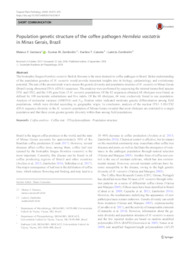Population genetic structure of the coffee pathogen Hemileia vastatrix in Minas Gerais, Brazil.
Population genetic structure of the coffee pathogen Hemileia vastatrix in Minas Gerais, Brazil.
Author(s): SANTANA, M. F.; ZAMBOLIM, E. M.; CAIXETA, E. T.; ZAMBOLIM, L.
Summary: The biotrophic fungus Hemileia vastatrix Berk & Broome is the most destructive coffee pathogen in Brazil. Better understanding of the population genetics of H. vastatrix would provide important insights into its biology, epidemiology, and evolutionary potential. The aim of the present study was to assess the genetic diversity and population structure of H. vastatrix in Minas Gerais (Brazil) using ribosomal DNA (rDNA) sequences. The analyzes were performed by sequencing the internal transcribed spacers ITS1 and ITS2, and the 5.8S gene from 15 H. vastatrix populations. Of the 82 sequences obtained, 68 ribotypes were found, as defined by 108 nucleotide substitutions and five indels. Of the 68 ribotypes, 64 were exclusively found in one population. Analysis of molecular variance (AMOVA) and FST fixation index indicated moderate genetic differentiation among field populations, which were divided according to geographic origin. In conclusion, analysis of the nuclear ITS1?5.8S-ITS2 rDNA sequence diversity in the H. vastatrix population of Minas Gerais revealed that most ribotypes are restricted to a single population and that there exists greater genetic diversity within than among field populations.
Publication year: 2018
Types of publication: Journal article
Unit: Embrapa Coffee
Keywords: Coffea Arábica, Coffee rust, ITS polymorphism, Population structure
Observation
Some of Embrapa's publications are published as ePub files. To read them, use or download one of the following free software options to your computer or mobile device. Android: Google Play Books; IOS: iBooks; Windows and Linux: Calibre.
Access other publications
Access the Agricultural Research Database (BDPA) to consult Embrapa's full library collection and records.
Visit Embrapa Bookstore to purchase books and other publications sold by Embrapa.

